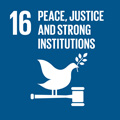- Docente: Alessandra Zanobetti
- Credits: 9
- Language: Italian
- Teaching Mode: In-person learning (entirely or partially)
- Campus: Bologna
- Corso: Single cycle degree programme (LMCU) in Law (cod. 9232)
Learning outcomes
The course is aimed at introducing students to the fundamental tenets of contemporary international law.
Course contents
The course illustrates the law–making, law–determination and law–enforcement of the rules of the International Community.
Specific regard will be devoted to differences and similarities between international law and domestic law. In order to facilitate the understanding of the contents of the course, special focus will be devoted to the past and current social-political events in the International Community.
International law will be presented in its various dimensions, namely: (a) as a source of rules of conduct for States (and their organs) in exercising their sovereignty on international issues; (b) as a communication tool aimed at reaching a consensus or, at least, as a peaceful instrument for managing disagreements; (c) as for a prism through which to look at the current political and social events in the International Community; (d) as a concrete tool to handle changes and challenges and to safeguard of the core stability and predictability of international legal relations;
The course will address the following subjects:
I. Law in International Society
- International Law in Historical and Evolutionary Perspectives
- International and Domestic Legal Orders: Analogies and Differences
- International Law in the Social Context
- Relativity and Dialectics in the Interpretation of International Rules
- Effectiveness of International Rules: Spontaneous Observance and Forced Compliance
II. Formation and Transformation of International Law
- Absence of legislature universal law-making organ
- Modern international society between “Internationalism” and “Nationalism”
- Customary international law
- International agreements, treaties of codification and custom as tacit agreement
- General principles of law
- “Soft- law” instruments
- Conflicts and compatibility between international rules
- Subjects of international law: States, intergovernmental and non-governamental organizations.
III. Ascertainment of, Application of and Compliance with International Law
- The role of States and of theirs legislative, administrative and judicial bodies
- Intergovernmental Organizations and the settlement of disputes between States
- The Role of NGOs
- Judicial function and diplomatic settlement of international disputes
- The ascertainment of International Criminal Law
- Individual criminal responsibility and State responsibility
- Basic principles on ascertainment and application of international rules
- Treaty interpretation
- Invalidity, extinction or suspension of treaties
- Interpretation and application of international custom
- General principles in the interpretation and application of international law
- Conflict of rules: lex superior, lex posterior, lex specialis
- Non-compliance, unlawfulness and international responsibility of States and intergovernmental organizations
IV. Execution of International Rules
- Countermeasures
- Self–Defence
- The United Nations collective security system
- The role of domestic legal orders
V. Substantive law
- Human Rights Law
- Environmental Law
- Law of the Sea
- Economic Law
- Law of Immunities
- International Organizations
- Migration law
Readings/Bibliography
A. Tanzi, Introduzione al diritto internazionale contemporaneo, CEDAM, 6a ed., 2019.
Teaching methods
The course consists in 30 lectures of 2 h. each. The teacher will make use of slides that will help attending students to better follow the explanations and facilitate the review of the topics.
Assessment methods
As from 1st June 2022 and until further notice, international students can choose between sitting the exam in presence or online.
There are two options available:
a) oral exam; b) written test. To register the mark, it is however necessary to register on Almaesami (when the lists are open). Students opting for the online exam will receive a link to the platform on which the exam will take place, but only when the lists are closed (basically on the eve of the exam).
a) The oral exam consists of the answer to two / three questions on the program. The exam is in presence or, it the students prefer, online on Teams (this option is open only to international exchange students). In this case, a connection with audio and camera is required, preferably with a computer or tablet. During the examination, the hands must remain visible. It is necessary to show the teacher a document so that identity can be verified. No more than a certain number of students can be examined per day (online exams take much longer) and therefore students must choose one of the official dates but may have to take the exam the next day or even the following day.
b) The written exam consists of 15 questions with 3 possible answers (1 correct, 2 false) on the course program, identical for attending and non-attending students. Students have 20 minutes to answer. With 15 correct answers, the mark will be 30 cum laude; 13/14 replies, 30; 12 answers: 28; 11 answers: 27; 10 answers: 26; 9 answers: 25; 8 answers: 24. With 7 or less correct answers, the exam must be repeated. Students who prefer to refuse the mark will have to repeat the written exam on the following date. In case of connection problems, the students may exceptionally ask to be admitted to take the oral exam in the same appeal, or they will have to repeat the written to the next appeal. In January 2022 the exam will be online on Teams. For February 2022 students will receive an update.
Upon cessation of the health emergency, the procedures for carrying out the examination will be specified again.
Teaching tools
Reference materials will be available at: https://iol.unibo.it/.
Office hours
See the website of Alessandra Zanobetti
SDGs




This teaching activity contributes to the achievement of the Sustainable Development Goals of the UN 2030 Agenda.
